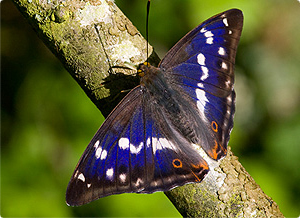Purple Emperor Butterfly
Apatura Iris
Members adopting this butterfly: Piyush, Kishore, Narendra, Kana, Hatisse, Simon, Susan
Purple Emperor Butterfly
Male Purple Emperors are distinctive with white on black markings with a purple sheen. Female Purple Emperors are slightly larger than the male. They have bolder markings and lack the purple sheen. They are endangered from localised areas.
When you might see them
You can find Purple Emperors in summer throughout the months of June to August.
Food
Male Purple Emperors feed on salts in moist ground or in animal droppings or rotting flesh. Purple Emperors also like feeding on Honeydew and tree sap. They drink from woodland puddles and also eat goat willow leaves.
Where – Habitat
Male Purple Emperors are found around oak trees. You might see some Purple Emperors on hedgerows or open fields. Female Purple Emperors are rarely seen as they spend most of their time on treetops. This type of butterfly is mostly found in the South East. Purple Emperors don’t go far from mixed forests, though wandering individuals may occasionally be encountered following hedgerows, or even crossing open fields.
Purple Emperor Eggs
They are Dome shaped green eggs but the base of the egg gradually turns purple as the egg ages.
When
The eggs would be laid in august on the upper side of a goats willow leaf. The egg would then take ten days to hatch.
Purple Emperor Caterpillar
The Caterpillar can grow 35 – 40mm, is very well camouflaged green when first hatched by November it turns brown ready for winter. In spring caterpillars can become green again. They have distinctive horns on their heads.
When
The caterpillar lives from September to next June.
Food
Caterpillars like feeding on goats willow leaves. After hibernation the caterpillar will resume feeding in spring.
Where
After the egg hatches the small caterpillar will crawl to the tip of its leaf and sit facing inwards towards the stalk. They are green when they are first hatched but will change to a muddy brown colour during November. They leave their leaf that they have lived on ready for the winter so that they can hibernate on a crotch of a forked branch.
Purple Emperor Chrysalis
The chrysalis is 30-35mm. The Chrysalis’s camouflage strongly resembles the leaf of a willow.
When
The caterpillar becomes a chrysalis around June or July. The chrysalis of a Purple Emperor will then become an adult butterfly during mid July.
Where
You will find a Purple Emperor’s chrysalis hanging upside down attached to a leaf or a stem.
Books used to find information
Britain’s Butterflies
A field guide to the butterflies of Britain and Ireland.
Written by David Newland, Robert Still, David Tomlinson and Andy Swash
The Butterflies of Britain and Ireland
Written by Jeremy Thomas and Richard Lewington
Guide to the butterflies of Britain
Written by John Bebbington
Usborne Spotter’s Guides – Butterflies
Written by George E. Hyde
BBC Gardeners World Magazine
Issue July 2011




